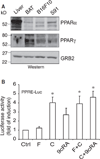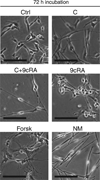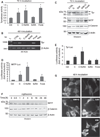PPAR gamma regulates MITF and beta-catenin expression and promotes a differentiated phenotype in mouse melanoma S91
- PMID: 18444964
- PMCID: PMC3951148
- DOI: 10.1111/j.1755-148X.2008.00460.x
PPAR gamma regulates MITF and beta-catenin expression and promotes a differentiated phenotype in mouse melanoma S91
Abstract
Melanoma represents one of the most rapidly metastasizing, hence deadly tumors due to its high proliferation rate and invasiveness, characteristics of undifferentiated embryonic tissues. Given the absence of effective therapy for metastatic melanoma, understanding more fully the molecular mechanisms underlying melanocyte differentiation may provide opportunities for novel therapeutic intervention. Here we show that in mouse melanoma S91 cells activation of the peroxisome proliferator activated receptor (PPAR) gamma induces events resembling differentiation, such as growth arrest accompanied by apoptosis, spindle morphology and enhanced tyrosinase expression. These events are preceded by an initial transient increase in expression from the Microphthalmia-associated transcription factor gene, (MITF) promoter, whereas exposure to a PPAR gamma ligand- ciglitazone that exceeds 8 h, causes a gradual decrease of MITF, until by 48 h MITF expression is substantially reduced. Beta-catenin, an MITF transcriptional activator, shows a similar pattern of decline during ciglitazone treatment, consistent with previous reports that activated PPAR gamma inhibits the Wnt/beta-catenin pathway through induction of beta-catenin proteasomal degradation. We suggest that the PPAR gamma-mediated beta-catenin down-regulation is likely to be responsible for changes in MITF levels. The data suggest that PPAR gamma, besides its well-established role in mesenchymal cell differentiation towards adipocytes, might regulate differentiation in the melanocytic lineage.
Figures




References
-
- Aiello A, Pandini G, Frasca F, Conte E, Murabito A, Sacco A, Genua M, Vigneri R, Belfiore A. Peroxisomal proliferator-activated receptor-gamma agonists induce partial reversion of epithelial-mesenchymal transition in anaplastic thyroid cancer cells. Endocrinology. 2006;147:4463–4475. - PubMed
-
- Anderson DJ. The neural crest cell lineage problem: neuropoesis? Neuron. 1989;3:1–12. - PubMed
-
- Bennett DC, Medrano EE. Molecular regulation of melanocyte senescence. Pigment Cell Res. 2002;15:242–250. - PubMed
Publication types
MeSH terms
Substances
Grants and funding
LinkOut - more resources
Full Text Sources
Medical

